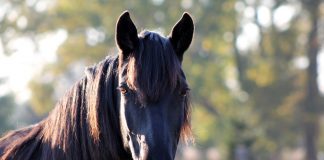By Cindy Hale
The mature blister beetle is approximately one-inch in length, and is always dark in color. It may also have stripes atop its back. The antennae are noticeable, being almost one-third the length of the beetle’s body.
The beetles often follow a grasshopper invasion, as its larva feed on the egg pods of grasshoppers. Later, the beetles feed on the alfalfa blooms. When the hay is cut and baled, the beetles are crimped or crushed, which only exposes their caustic juices further. While it can take up to 100 blister beetles to kill a horse, much fewer can raise blisters on the inside of a horse’s mouth or cause a bout of colic. Be on the beetle lookout. Watch for the dried insects pressed inside flakes of alfalfa. If you notice any, discard the feed.






a picture would be helpful
From south central Kansas – I have a photo of a swarm and close-ups of striped blister beetles on alfalfa which were taken a week ago. I’ll see if I can figure out how to post them to this website. Although they leave the alfalfa as soon as it is cut, the toxicity can be imbedded in the hay from tractor/mower wheels or from conditioning the hay by crushing the fluids of the beetles’ bodies into the stem and leaves. Just because beetle bodies are not present in the hay doesn’t mean that it cannot be tainted, but examining it for corpses can help. The beetles also become very active when the temperatures are over 90 degrees. Usually by mid August, they receed into the soil to lay eggs for the next year. Thus, I keep my first (April) cutting and last (late September/early October) cutting and sell the summer cuttings to farmers for their cows.
Very scary – definitely need to be on the look out for that
this article is great but I am from Southern Missouri. I just moved here 4 years ago and have 4 mares that I brought out with me. The mares were raised on alfalfa hay so the grass hay here isn’t very appealing to them. Especially my 26 year old quarter horse. She has alot of weight since I have moved from Arizona. Out there they spray for the blister bug. So does anyone have a suggestion on when to buy alfalfa hay out in Missouri?
Thanks,
Good article
I worry about these but I don’t think we have them here. Phew~!